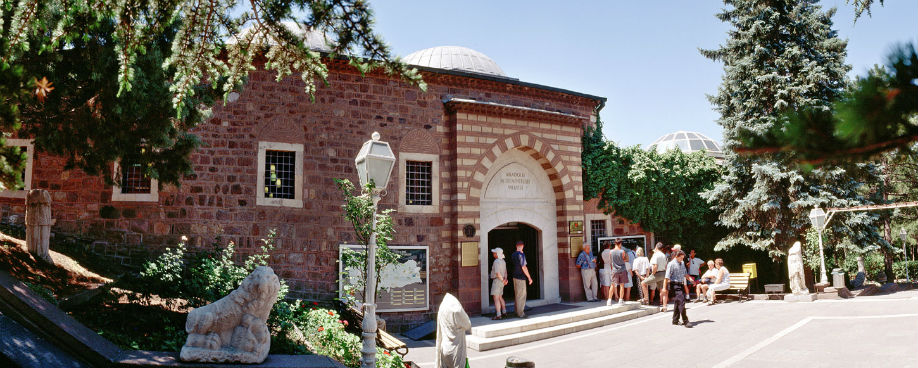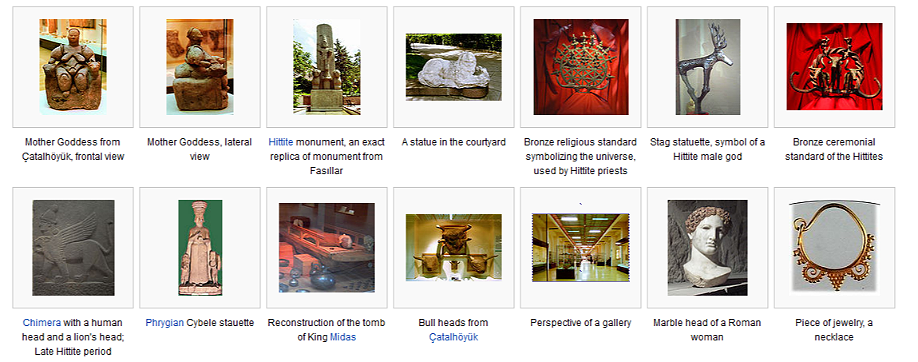The superb Museum of Anatolian Civilisations is the perfect introduction to the complex weave of Turkey’s ancient past, housing artefacts cherry-picked from just about every significant archaeological site in Anatolia.
The museum is housed in a beautifully restored 15th-century bedesten (covered market). The 10-domed central marketplace houses reliefs and statues, while the surrounding hall displays exhibits from the earlier Anatolian civilisations: Palaeolithic, Neolithic, Chalcolithic, Bronze Age, Assyrian, Hittite, Phrygian, Urartian and Lydian. The downstairs sections hold classical Greek and Roman artefacts and a display on Ankara’s history. Get there early to avoid the flood of tour groups and school parties.
The exhibits are chronologically arranged in a spiral: start at the Palaeolithic and Neolithic displays in the room to the right of the entrance, then continue in an anticlockwise direction, visiting the central room last.
Items from one of the most important Neolithic sites in the world Çatalhöyük, southeast of Konya – are displayed here. There’s a mock-up of the inside of a dwelling typical of those uncovered at the site, one of the most famous mother goddess sculptures unearthed from the excavations and wall paintings of hunting scenes.
Also on show are many finds from the Assyrian trading colony Kültepe, one of the world’s oldest and wealthiest bazaars. These include baked-clay tablets found at the site, which dates to the beginning of the 2nd millenium BC.
One of the striking Hittite figures of bulls and stags in the next room used to be the emblem of Ankara. The Hittites were known for their relief work, and some mighty slabs representing the best pieces found in the country, generally from around Hattuşa, are on display in the museum’s central room.
Most of the finds from the Phrygian capital Gordion, including incredible inlaid wooden furniture, are on display in the museum’s last rooms. The exhibits also include limestone blocks with still-indecipherable inscriptions resembling the Greek alphabet, and lion- and ram-head ritual vessels that show the high quality of Phrygian metalwork.
Urartian artifacts are also on display here. Spurred by rich metal deposits, the Urartians were Anatolia’s foremost metalworkers, as the knives, horse-bit, votive plates and shields on display demonstrate. There are also terracotta figures of gods in human form, some revealing their divine powers by growing scorpion tails, and neo-Hittite artefacts.
Downstairs, classical-period finds and regional history displays provide a local picture. Excavations have unearthed a Roman road near the Column of Julian, and Ankara has its own ‘missing link’, the 9.8-million-year-old Ankarapithecus (a 30kg, fruit-eating primate).




I was unlucky in seeing this museum during renovation. but despite of this, I can recommend this as one of the best museums in Turkey that I have gone to (and I have seen quite a few).
the time-span of the artifacts and their presentation, even during renovation, was quite impressive and educational.
a trip to Ankara cannot be complete…
A great little museum in a beautiful location. A very good insight into the Anatolian civilizations. Well presented. No museum fatigue here.
Fabulous place with heaps of roman statues and jewelery from Troy. The hordes of school children took away a bit but was still worth every minute
Approximately 1/2 the Museum was closed for remodeling ("Bummer"). But, the half that was open was fabulous, and not to be missed ("Winner").
if you dont have lot of time in ankara i vote for ataturk museum than for anatolian
entry fees 15 TL plus 5TL if u need the audio
u can reach the citadel from there as well
if u use the stairs to go to citadel its 233 steps 🙂 bring your water wth u in order nt to fee…
With only an hour it is difficult to describe this gem of a museum of ancient civilizations that have left their mark on Turkey.The only museum this reminnds me of is the Anthropology Museum in Mexice City.
It is hard to describe the feeling one gets here seeing artifacts from the Neolithic age going back 10,000 years. The earliest "Mother Goddess" figure known to exist is on display here, as are 9,000 year-old wall paintings, bronze-age sculptures, gold figurines, Hittite statues, and more. One of the best of the best museums in the world!
It summarizes you the history of anatolia from 4000 bc to newer ages.It must be the first place to see in Ankara.As long as I see some arhcheological museums in other parts of Europa.This is one of the best.
Nice museum, you should allow about an hour to visit it.
Very nice artifacts with well documented listings.
This museum should be at the top of to do list in Ankara. It shows the cultural richness of Anatolia and hosts numerous invaluable historic artifacts.